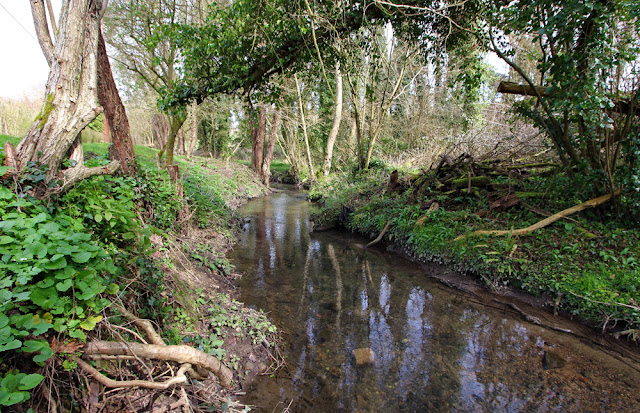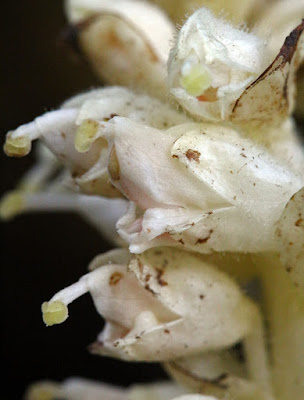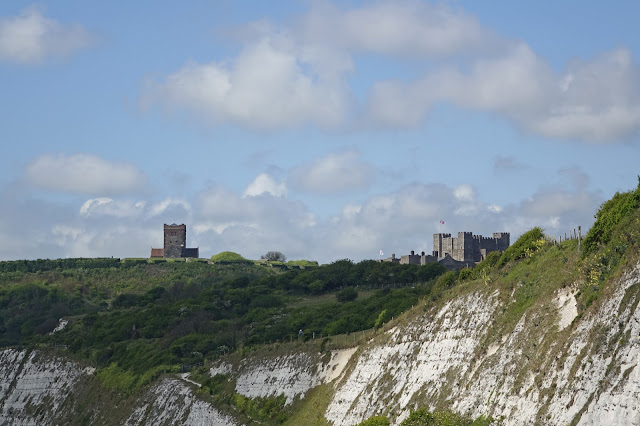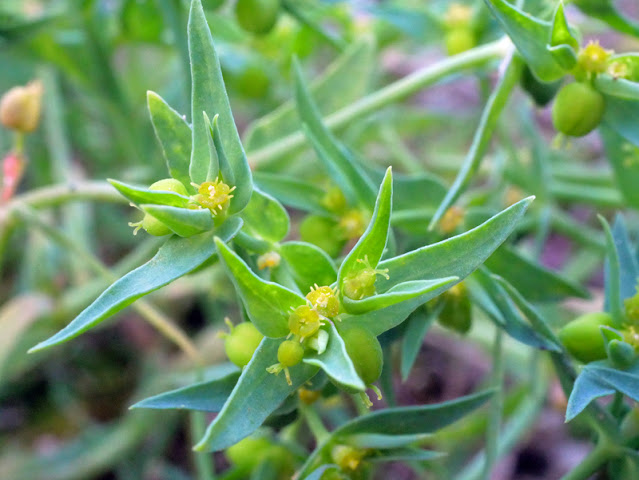River Bourne, Basted, Kent 3rd April 2016
Tucked away in rural Kent is a delightfull small river that runs through a quiet bird song filled valley. A public footpath runs parallel to the stream, most of it shaded by the Alder that loves wet ground. Yet this delightful oasis is but a few minutes from the M20 and M26!
The wet and boggy ground habitats gave me a chance to find wildflowers I normally miss, as most of my local area is dry chalky soils. Growing in a bog to one side of the river were several Marsh Marigolds, their bright yellow flowers standing out in the drab boggy ground.
These are native to the UK but are often found near habitation as escapes from garden ponds or Council planting. These were truly wild though and a delight to see.
Caltha palustris
All over the place were carpets of Opposite-leaved Golden Saxifrage. These have no petals on their flowers but the anthers glow gold in sunlight giving the appearance of thousands of tiny yellow flowers.
Chrysosplenium oppositifolium
Here's a tiny fly, I don't know what species, pollinating them. In turn these provide food for nesting woodland birds. The food chain all links back to plants in the end. Wipe out the plants and you wipe out everything else up that chain, simple really!
Another plant that loves damp areas is Ramsons, a type of wild garlic. There were thousands of them by the river and in a few weeks when they all flower, the valley will be filled with a lovely smell of garlic.
Allium ursinum
I then started to find these weird looking spikes. They are Great Horsetail, and actually, they are a fern. In a few weeks big feathery fronds will come up around the spikes (which release spores like any other fern).
While common, they aren't often seen in my part of Kent.
Here's a close up.
Equisetum telemateia
There was plenty of entomological interest as well. This is an Eristalis species of Hoverly on a Blackthorn flower.
Ground Ivy is a common plant but at this time of year, their tiny fresh flowers are quite attractive and an important nectar source for insects.
Glechoma hederacea
Garden escapes are numerous in the wild and many have completely naturalised, such as this Russian Comfrey. It has spread right along the river from a garden well upstream.
Symphytum x uplandicum
For a week or so I had noticed Yellow Archangel leaves in woodlands but here is the first open flower of 2016 I have found.
When in full flower, they have a whorl of these flowers wrapping around the stem at intervals up it, they look fantastic.
Lamiastrum galeobdolong
After about a kilometre, I came to an old ruined watermill with a small weir. This gave me an excuse to muck around with the shutter settings on the camera to make the water look fluid in the photo.
While down low I noticed numerous small black spiders running about quite fast. I finally crept up on one to take its portrait.
It's a type of Wolf spider.
Pardosa species
Moschatel or Town Hall Clock grew in abundance. This is a shade loving species and grows in dry areas as well. It's easily missed as the flowers are green and they are about 3-6" tall, so quite small. They are uniqur in that they have a cubed shaped flower, with 5 sides flowering!
Adoxa moschatellina
At the end of the river valley, I climbed a hill to drier chalky soil and under Hazel I found these stunning Toothworts. These have no chlorophyl, they don't need energy from sunlight as they tap into the roots of the Hazel tree and get their energy there. They don't seem to harm the tree and are now becoming quite uncommon.
The flowers all grow on the same side of the stem causing the plant to droop.
Everything about this plant is weird, even the flowers themselves. I don't know what insects pollinate them, but I suspect flies and hoverflies as the plant grows in shady areas.
Lathraea squamaria
As I retraced my steps, the final thing of interest was this Bee Fly. I was fortunate that its pose was all inline so it's pin sharp from the tip of that huge proboscis to it backside. They are quite harmless to us, they don't bite! However, they flick their eggs into solitary bee nests and when they hatch they eat the bees young!
Bombylius major
That was about it for that day, a very enjoyable walk. Nature is fast waking up and soon the woodlands will be saturated in Spring flowers, making the most of the time before the trees come into leaf, I'm looking forward to it!
Dave
The wet and boggy ground habitats gave me a chance to find wildflowers I normally miss, as most of my local area is dry chalky soils. Growing in a bog to one side of the river were several Marsh Marigolds, their bright yellow flowers standing out in the drab boggy ground.
These are native to the UK but are often found near habitation as escapes from garden ponds or Council planting. These were truly wild though and a delight to see.
Caltha palustris
All over the place were carpets of Opposite-leaved Golden Saxifrage. These have no petals on their flowers but the anthers glow gold in sunlight giving the appearance of thousands of tiny yellow flowers.
Chrysosplenium oppositifolium
Here's a tiny fly, I don't know what species, pollinating them. In turn these provide food for nesting woodland birds. The food chain all links back to plants in the end. Wipe out the plants and you wipe out everything else up that chain, simple really!
Another plant that loves damp areas is Ramsons, a type of wild garlic. There were thousands of them by the river and in a few weeks when they all flower, the valley will be filled with a lovely smell of garlic.
Allium ursinum
I then started to find these weird looking spikes. They are Great Horsetail, and actually, they are a fern. In a few weeks big feathery fronds will come up around the spikes (which release spores like any other fern).
While common, they aren't often seen in my part of Kent.
Here's a close up.
Equisetum telemateia
There was plenty of entomological interest as well. This is an Eristalis species of Hoverly on a Blackthorn flower.
Ground Ivy is a common plant but at this time of year, their tiny fresh flowers are quite attractive and an important nectar source for insects.
Glechoma hederacea
Garden escapes are numerous in the wild and many have completely naturalised, such as this Russian Comfrey. It has spread right along the river from a garden well upstream.
Symphytum x uplandicum
For a week or so I had noticed Yellow Archangel leaves in woodlands but here is the first open flower of 2016 I have found.
When in full flower, they have a whorl of these flowers wrapping around the stem at intervals up it, they look fantastic.
Lamiastrum galeobdolong
After about a kilometre, I came to an old ruined watermill with a small weir. This gave me an excuse to muck around with the shutter settings on the camera to make the water look fluid in the photo.
While down low I noticed numerous small black spiders running about quite fast. I finally crept up on one to take its portrait.
It's a type of Wolf spider.
Pardosa species
Moschatel or Town Hall Clock grew in abundance. This is a shade loving species and grows in dry areas as well. It's easily missed as the flowers are green and they are about 3-6" tall, so quite small. They are uniqur in that they have a cubed shaped flower, with 5 sides flowering!
Adoxa moschatellina
At the end of the river valley, I climbed a hill to drier chalky soil and under Hazel I found these stunning Toothworts. These have no chlorophyl, they don't need energy from sunlight as they tap into the roots of the Hazel tree and get their energy there. They don't seem to harm the tree and are now becoming quite uncommon.
The flowers all grow on the same side of the stem causing the plant to droop.
Everything about this plant is weird, even the flowers themselves. I don't know what insects pollinate them, but I suspect flies and hoverflies as the plant grows in shady areas.
Lathraea squamaria
As I retraced my steps, the final thing of interest was this Bee Fly. I was fortunate that its pose was all inline so it's pin sharp from the tip of that huge proboscis to it backside. They are quite harmless to us, they don't bite! However, they flick their eggs into solitary bee nests and when they hatch they eat the bees young!
Bombylius major
That was about it for that day, a very enjoyable walk. Nature is fast waking up and soon the woodlands will be saturated in Spring flowers, making the most of the time before the trees come into leaf, I'm looking forward to it!
Dave




















Hi, are you sure your comfrey is Russian Comfrey, going by the flowers and time of year could it be Hidcote Comfrey (S. hidcotense 'Hidcote Blue')? A low growing thug that spreads by creeping rhizomes to form large stands.
ReplyDeleteHidcote isn't in my books, but I'll double check and possibly ask my county recorder to help, thanks for the heads up. I have other photos of the upper stem leaves not published here.
ReplyDeleteDave